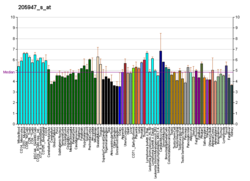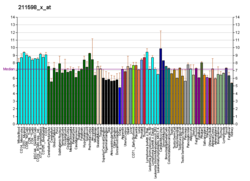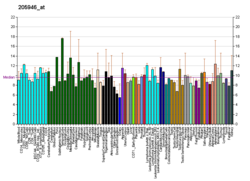VIPR2
| VIPR2 | |||||||||||||||||||||||||||||||||||||||||||||||||||
|---|---|---|---|---|---|---|---|---|---|---|---|---|---|---|---|---|---|---|---|---|---|---|---|---|---|---|---|---|---|---|---|---|---|---|---|---|---|---|---|---|---|---|---|---|---|---|---|---|---|---|---|
| |||||||||||||||||||||||||||||||||||||||||||||||||||
| Identifiers | |||||||||||||||||||||||||||||||||||||||||||||||||||
| Aliases | VIPR2, C16DUPq36.3, DUP7q36.3, PACAP-R-3, PACAP-R3, VIP-R-2, VPAC2, VPAC2R, VPCAP2R, vasoactive intestinal peptide receptor 2 | ||||||||||||||||||||||||||||||||||||||||||||||||||
| External IDs | OMIM: 601970; MGI: 107166; HomoloGene: 2540; GeneCards: VIPR2; OMA:VIPR2 - orthologs | ||||||||||||||||||||||||||||||||||||||||||||||||||
| |||||||||||||||||||||||||||||||||||||||||||||||||||
| |||||||||||||||||||||||||||||||||||||||||||||||||||
| |||||||||||||||||||||||||||||||||||||||||||||||||||
| |||||||||||||||||||||||||||||||||||||||||||||||||||
| |||||||||||||||||||||||||||||||||||||||||||||||||||
| Wikidata | |||||||||||||||||||||||||||||||||||||||||||||||||||
| |||||||||||||||||||||||||||||||||||||||||||||||||||
Vasoactive intestinal peptide receptor 2 also known as VPAC2, is a G-protein coupled receptor that in humans is encoded by the VIPR2 gene.[5]
Tissue distribution
[edit]VIPR2 is expressed in the uterus, prostate, smooth muscle of the gastrointestinal tract, seminal vesicles and skin, blood vessels and thymus.[6][7] VIPR2 is also expressed in the cerebellum.[8]
Function
[edit]Vasoactive intestinal peptide (VIP) and pituitary adenylate cyclase activating polypeptide (PACAP) are homologous peptides that function as neurotransmitters and neuroendocrine hormones. While the receptors for VIP (VIRP 1 and 2) and PACAP (ADCYAP1R1) share homology, they differ in their substrate specificities and expression patterns.[5] VIPR2 transduction results in upregulation of adenylate cyclase activity.[9] Furthermore, VIPR2 mediates the anti-inflammatory effects of VIP.[10]
Research using VPAC2 knockout mice implicate it in the function of the circadian clock, growth, basal energy expenditure and male reproduction.[11][12][13][14]
VIPR2 and/or PAC1 receptor activation is involved in cutaneous active vasodilation in humans.[15]
Splice variants may modify the immunoregulatory contributions of the VIP-VIPR2 axis.[16]
VIPR2 may contribute to autoregulation and/or coupling within the suprachiasmatic nucleus (SCN) core and to control of the SCN shell.[17]
Clinical significance
[edit]VIPR2 may play a role in schizophrenia.[18]
The abnormal expression of VIPR2 messenger RNA in gallbladder tissue may play a role in the formation of gall stones and polyps.[19]
See also
[edit]References
[edit]- ^ a b c GRCh38: Ensembl release 89: ENSG00000106018 – Ensembl, May 2017
- ^ a b c GRCm38: Ensembl release 89: ENSMUSG00000011171 – Ensembl, May 2017
- ^ "Human PubMed Reference:". National Center for Biotechnology Information, U.S. National Library of Medicine.
- ^ "Mouse PubMed Reference:". National Center for Biotechnology Information, U.S. National Library of Medicine.
- ^ a b "Entrez Gene: VIPR2 vasoactive intestinal peptide receptor 2". Archived from the original on 5 December 2010.
- ^ Reubi JC (2000). "In vitro evaluation of VIP/PACAP receptors in healthy and diseased human tissues. Clinical implications". Ann N Y Acad Sci. 921 (1): 1–25. Bibcode:2000NYASA.921....1R. doi:10.1111/j.1749-6632.2000.tb06946.x. PMID 11193811. S2CID 21204750.
- ^ Reubi JC, Laderach U, Waser B, Gebbers JO, Robberecht P, Laissue JA (2000). "Vasoactive intestinal peptide/pituitary adenylate cyclase-activating peptide receptor subtypes in human tumors and their tissues of origin". Cancer Res. 60 (11): 3105–3112. PMID 10850463.
- ^ Basille M, Cartier D, Vaudry D, Lihrmann I, Fournier A, Freger P, Gallo-Payet N, Vaudry H, Gonzalez B (June 2006). "Localization and characterization of pituitary adenylate cyclase-activating polypeptide receptors in the human cerebellum during development". J. Comp. Neurol. 496 (4): 468–78. doi:10.1002/cne.20934. PMID 16572459. S2CID 9385702.
- ^ "IUPHAR-DB VPAC2 receptor Redirect". www.iuphar-db.org. Archived from the original on 3 March 2016. Retrieved 7 May 2018.
- ^ Juarranz Y, Gutiérrez-Cañas I, Santiago B, Carrión M, Pablos JL, Gomariz RP (April 2008). "Differential expression of vasoactive intestinal peptide and its functional receptors in human osteoarthritic and rheumatoid synovial fibroblasts". Arthritis Rheum. 58 (4): 1086–95. doi:10.1002/art.23403. PMID 18383383.
- ^ Harmar AJ, Marston HM, Shen S, Spratt C, West KM, Sheward WJ, Morrison CF, Dorin JR, Piggins HD, Reubi JC, Kelly JS, Maywood ES, Hastings MH (2002). "The VPAC2 receptor is essential for circadian function in the mouse suprachiasmatic nuclei". Cell. 109 (4): 497–508. doi:10.1016/S0092-8674(02)00736-5. PMID 12086606. S2CID 18583905.
- ^ Cutler DJ, Haraura M, Reed HE, Shen S, Sheward WJ, Morrison CF, Marston HM, Harmar AJ, Piggins HD (January 2003). "The mouse VPAC2 receptor confers suprachiasmatic nuclei cellular rhythmicity and responsiveness to vasoactive intestinal polypeptide in vitro". Eur. J. Neurosci. 17 (2): 197–204. doi:10.1046/j.1460-9568.2003.02425.x. PMID 12542655. S2CID 2507786.
- ^ Hughes AT, Fahey B, Cutler DJ, Coogan AN, Piggins HD (April 2004). "Aberrant gating of photic input to the suprachiasmatic circadian pacemaker of mice lacking the VPAC2 receptor". J. Neurosci. 24 (14): 3522–6. doi:10.1523/JNEUROSCI.5345-03.2004. PMC 6729740. PMID 15071099.
- ^ Asnicar MA, Köster A, Heiman ML, Tinsley F, Smith DP, Galbreath E, Fox N, Ma YL, Blum WF, Hsiung HM (October 2002). "Vasoactive intestinal polypeptide/pituitary adenylate cyclase-activating peptide receptor 2 deficiency in mice results in growth retardation and increased basal metabolic rate". Endocrinology. 143 (10): 3994–4006. doi:10.1210/en.2002-220354. PMID 12239111.
- ^ Kellogg DL, Zhao JL, Wu Y, Johnson JM (July 2010). "VIP/PACAP receptor mediation of cutaneous active vasodilation during heat stress in humans". J. Appl. Physiol. 109 (1): 95–100. doi:10.1152/japplphysiol.01187.2009. PMC 2904198. PMID 20395540.
- ^ Miller AL, Verma D, Grinninger C, Huang MC, Goetzl EJ (July 2006). "Functional splice variants of the type II G protein-coupled receptor (VPAC2) for vasoactive intestinal peptide in mouse and human lymphocytes". Ann. N. Y. Acad. Sci. 1070 (1): 422–6. Bibcode:2006NYASA1070..422M. doi:10.1196/annals.1317.055. PMC 1557659. PMID 16888203.
- ^ Kalló I, Kalamatianos T, Wiltshire N, Shen S, Sheward WJ, Harmar AJ, Coen CW (April 2004). "Transgenic approach reveals expression of the VPAC2 receptor in phenotypically defined neurons in the mouse suprachiasmatic nucleus and in its efferent target sites". Eur. J. Neurosci. 19 (8): 2201–11. doi:10.1111/j.0953-816X.2004.03335.x. PMID 15090046. S2CID 2389771.
- ^ Levinson DF, Duan J, Oh S, Wang K, Sanders AR, Shi J, Zhang N, Mowry BJ, Olincy A, Amin F, Cloninger CR, Silverman JM, Buccola NG, Byerley WF, Black DW, Kendler KS, Freedman R, Dudbridge F, Pe'er I, Hakonarson H, Bergen SE, Fanous AH, Holmans PA, Gejman PV (February 2011). "Copy Number Variants in Schizophrenia: Confirmation of Five Previous Findings and New Evidence for 3q29 Microdeletions and VIPR2 Duplications". Am J Psychiatry. 168 (3): 302–316. doi:10.1176/appi.ajp.2010.10060876. PMC 4441324. PMID 21285140.
- ^ Zhang ZH, Wu SD, Gao H, Shi G, Jin JZ, Kong J, Tian Z, Su Y (March 2006). "Expression of pituitary adenylate cyclase-activating polypeptide 1 and 2 receptor mRNA in gallbladder tissue of patients with gallstone or gallbladder polyps". World J. Gastroenterol. 12 (9): 1468–71. doi:10.3748/wjg.v12.i9.1468. PMC 4124332. PMID 16552823.
Further reading
[edit]- Goetzl EJ, Pankhaniya RR, Gaufo GO, et al. (1998). "Selectivity of effects of vasoactive intestinal peptide on macrophages and lymphocytes in compartmental immune responses". Ann. N. Y. Acad. Sci. 840 (1 NEUROIMMUNOMO): 540–50. Bibcode:1998NYASA.840..540G. doi:10.1111/j.1749-6632.1998.tb09593.x. PMID 9629281. S2CID 11871747.
- Adamou JE, Aiyar N, Van Horn S, Elshourbagy NA (1995). "Cloning and functional characterization of the human vasoactive intestinal peptide (VIP)-2 receptor". Biochem. Biophys. Res. Commun. 209 (2): 385–92. doi:10.1006/bbrc.1995.1515. PMID 7733904.
- Svoboda M, Tastenoy M, Van Rampelbergh J, et al. (1995). "Molecular cloning and functional characterization of a human VIP receptor from SUP-T1 lymphoblasts". Biochem. Biophys. Res. Commun. 205 (3): 1617–24. doi:10.1006/bbrc.1994.2852. PMID 7811244.
- Inagaki N, Yoshida H, Mizuta M, et al. (1994). "Cloning and functional characterization of a third pituitary adenylate cyclase-activating polypeptide receptor subtype expressed in insulin-secreting cells". Proc. Natl. Acad. Sci. U.S.A. 91 (7): 2679–83. Bibcode:1994PNAS...91.2679I. doi:10.1073/pnas.91.7.2679. PMC 43433. PMID 8146174.
- Xia M, Gaufo GO, Wang Q, et al. (1996). "Transduction of specific inhibition of HuT 78 human T cell chemotaxis by type I vasoactive intestinal peptide receptors". J. Immunol. 157 (3): 1132–8. doi:10.4049/jimmunol.157.3.1132. PMID 8757618. S2CID 40867208.
- Wei Y, Mojsov S (1997). "Tissue specific expression of different human receptor types for pituitary adenylate cyclase activating polypeptide and vasoactive intestinal polypeptide: implications for their role in human physiology". J. Neuroendocrinol. 8 (11): 811–7. doi:10.1046/j.1365-2826.1996.05191.x. PMID 8933357. S2CID 22302790.
- Mackay M, Fantes J, Scherer S, et al. (1997). "Chromosomal localization in mouse and human of the vasoactive intestinal peptide receptor type 2 gene: a possible contributor to the holoprosencephaly 3 phenotype". Genomics. 37 (3): 345–53. doi:10.1006/geno.1996.0569. PMID 8938447.
- Nicole P, Du K, Couvineau A, Laburthe M (1998). "Site-directed mutagenesis of human vasoactive intestinal peptide receptor subtypes VIP1 and VIP2: evidence for difference in the structure-function relationship". J. Pharmacol. Exp. Ther. 284 (2): 744–50. PMID 9454823.
- Dewit D, Gourlet P, Amraoui Z, et al. (1998). "The vasoactive intestinal peptide analogue RO25-1553 inhibits the production of TNF and IL-12 by LPS-activated monocytes". Immunol. Lett. 60 (1): 57–60. doi:10.1016/S0165-2478(97)00129-6. PMID 9541464.
- Lutz EM, Shen S, Mackay M, et al. (1999). "Structure of the human VIPR2 gene for vasoactive intestinal peptide receptor type 2" (PDF). FEBS Lett. 458 (2): 197–203. doi:10.1016/S0014-5793(99)01135-7. hdl:20.500.11820/4a02420b-ff08-47b1-a44f-42cb7b326647. PMID 10481065. S2CID 27842682.
- Busto R, Prieto JC, Bodega G, et al. (2000). "Immunohistochemical localization and distribution of VIP/PACAP receptors in human lung". Peptides. 21 (2): 265–9. doi:10.1016/S0196-9781(99)00202-8. PMID 10764955. S2CID 44951090.
- Nicole P, Lins L, Rouyer-Fessard C, et al. (2000). "Identification of key residues for interaction of vasoactive intestinal peptide with human VPAC1 and VPAC2 receptors and development of a highly selective VPAC1 receptor agonist. Alanine scanning and molecular modeling of the peptide". J. Biol. Chem. 275 (31): 24003–12. doi:10.1074/jbc.M002325200. PMID 10801840.
- Bajo AM, Juarranz MG, Valenzuela P, et al. (2001). "Expression of vasoactive intestinal peptide (VIP) receptors in human uterus". Peptides. 21 (9): 1383–8. doi:10.1016/S0196-9781(00)00282-5. PMID 11072126. S2CID 429907.
- Lara-Marquez M, O'Dorisio M, O'Dorisio T, et al. (2001). "Selective gene expression and activation-dependent regulation of vasoactive intestinal peptide receptor type 1 and type 2 in human T cells". J. Immunol. 166 (4): 2522–30. doi:10.4049/jimmunol.166.4.2522. PMID 11160313.
- Lara-Marquez ML, O'Dorisio MS, Karacay B (2001). "Vasoactive intestinal peptide (VIP) receptor type 2 (VPAC2) is the predominant receptor expressed in human thymocytes". Ann. N. Y. Acad. Sci. 921 (1): 45–54. doi:10.1111/j.1749-6632.2000.tb06950.x. PMID 11193874. S2CID 8156918.
- Groneberg DA, Hartmann P, Dinh QT, Fischer A (2001). "Expression and distribution of vasoactive intestinal polypeptide receptor VPAC(2) mRNA in human airways". Lab. Invest. 81 (5): 749–55. doi:10.1038/labinvest.3780283. PMID 11351046.
- Juarranz MG, Bolaños O, Gutiérrez-Cañas I, et al. (2002). "Neuroendocrine differentiation of the LNCaP prostate cancer cell line maintains the expression and function of VIP and PACAP receptors". Cell. Signal. 13 (12): 887–94. doi:10.1016/S0898-6568(01)00199-1. PMID 11728828.
- Fischer TC, Dinh QT, Peiser C, et al. (2002). "Simultaneous detection of receptor mRNA and ligand protein in human skin tissues". J. Cutan. Pathol. 29 (2): 65–71. doi:10.1034/j.1600-0560.2002.290201.x. PMID 12150135. S2CID 22886240.
- Strausberg RL, Feingold EA, Grouse LH, et al. (2003). "Generation and initial analysis of more than 15,000 full-length human and mouse cDNA sequences". Proc. Natl. Acad. Sci. U.S.A. 99 (26): 16899–903. Bibcode:2002PNAS...9916899M. doi:10.1073/pnas.242603899. PMC 139241. PMID 12477932.
External links
[edit]- "VIP and PACAP Receptors: VPAC2". IUPHAR Database of Receptors and Ion Channels. International Union of Basic and Clinical Pharmacology. Archived from the original on 3 March 2016. Retrieved 12 December 2008.
This article incorporates text from the United States National Library of Medicine, which is in the public domain.







